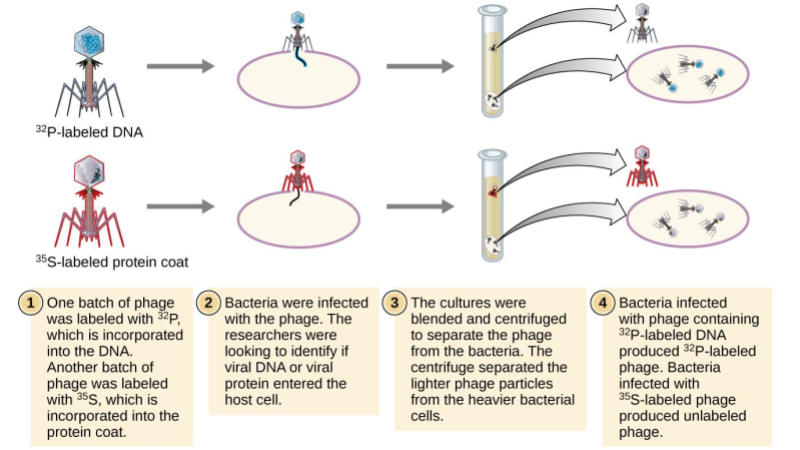DNA Detectives: The Case of the Radioactive Phosphorus

Once upon a time in the 1950s, there were two clever scientists named Alfred Hershey and Martha Chase. They were like the dynamic duo of science, on a mission to unlock the secrets of life itself. Their quest? To figure out what exactly carries the instructions for life from one generation to the next.
Now, at the time, scientists were hot on the trail of this mystery. They knew there had to be something special inside cells that carried these instructions, but they weren't quite sure what it was. Some thought it might be proteins, while others believed it could be DNA (deoxyribonucleic acid).
Alfred and Martha decided to put on their detective hats and conduct an experiment to crack the case once and for all. They chose to work with a type of virus called a bacteriophage, which infects bacteria. These sneaky viruses inject their genetic material into bacteria, hijacking them to make more virus particles.
First, Alfred and Martha labeled the viral DNA with radioactive phosphorus-32 (P-32). Why radioactive? Well, it's like putting a tracking device on the DNA, allowing them to follow its every move. Next, they labeled the protein coat of the virus with radioactive sulfur-35 (S-35). With these clever labels in place, they were ready to set their experiment in motion.
They let the viruses infect the bacteria, and then came the moment of truth. Alfred and Martha knew that if DNA was the hereditary material, then the radioactive P-32 would end up inside the bacteria, carrying the genetic instructions. But if it was the proteins, then the radioactive S-35 would be the ones smuggled into the bacteria.
They got to work, spinning the infected bacteria in a blender (yes, you read that right, a blender!) to separate the virus particles from the bacteria. Then, they checked to see which radioactive label ended up inside the bacteria.
Drumroll, please... the results were clear! It was the radioactive P-32, indicating that the DNA, not the proteins, carried the genetic instructions. Hershey and Chase had cracked the case wide open!
Their groundbreaking experiment provided solid evidence that DNA is indeed the hereditary material, laying the foundation for our modern understanding of genetics and DNA. Their work paved the way for countless discoveries in biology and medicine, making them true heroes in the world of science.
And so, the dynamic duo of Hershey and Chase rode off into the scientific sunset, their experiment forever etched in the annals of history as one of the greatest discoveries of all time.
Questions:
- What were Alfred Hershey and Martha Chase trying to discover?
- What did Alfred and Martha label the viral DNA with, and why?
- How did they label the protein coat of the virus?
- What did Alfred and Martha hope to determine with their experiment?
- Describe the process Alfred and Martha used to separate the virus particles from the bacteria.
- What were the results of their experiment, and what did it indicate about the hereditary material?
The Hershey Chase Experiment - CER

Image Source: commons.wikimedia.org/wiki/File:OSC_Microbio_10_01_HersheyChase.jpg
7. What CLAIM can be made from the experiment?
8. What EVIDENCE supports the claim?
9. Provide REASONING that connects the evidence to the claim. Consider wording your statement in an IF-THEN format.
Related Materials
Quiz: DNA Dectectives - The Hershey Chase Experiment